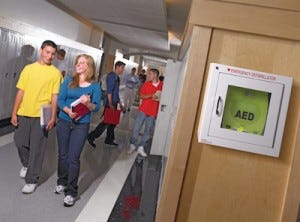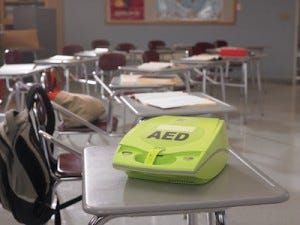Ensure the Best Placement of AEDs in Your School
- Sep 21, 2018
- 0 Comments
 The increasing square footage of schools can make determining how many automated external defibrillators (AEDs) and where to strategically place them seem like an overwhelming task. But it is a necessary task to ensure the best response in the event of sudden cardiac arrest (SCA). If you need help determining the best number and placement of AEDs in your school, connect with one of our experts.
The increasing square footage of schools can make determining how many automated external defibrillators (AEDs) and where to strategically place them seem like an overwhelming task. But it is a necessary task to ensure the best response in the event of sudden cardiac arrest (SCA). If you need help determining the best number and placement of AEDs in your school, connect with one of our experts.The American Heart Association recommends AEDs be accessible within three minutes of an SCA emergency. Every minute of delayed defibrillation equates to a 10% decrease in the chance of survival of the victim.1 When an AED is applied prior to the arrival of an ambulance, the victim’s chance of survival increases nearly fivefold.2
It’s important to consider the following when equipping your school with AEDs.
- Placement – AEDs should be placed within 3 minutes of anywhere within the facility. That means a responder has 1.5 minutes to get to the device and 1.5 minutes to get back to the victim when walking at a brisk pace. On average an individual walking at a pace of 4 miles per hour will walk 152 steps in 1 minute.3 That’s 228 steps to the device and 228 steps back. Determine your 1-minute radius and center an AED around that.
TIP: Consider obstacles in the pathways to AEDs. For instance; hallways with security doorways, multiple floors, furniture.
- Visibility – Make sure AEDs are easily located within your school by placing wall signs above the AED to direct responders to the location. Wall signs are sold separately from AEDs and budgets should allow for proper AED signage. A well-marked path to an AED can make the difference in the survival of a victim when minutes count.
TIP: Place a wall sign at the end of a hallway or at an entrance to direct responders to the location of an AED.
- Accessibility – Make sure the AED(s) is easily accessible to responders. Wall cabinets designed to hold AEDs are often alarmed and improve accessibility while deterring theft. The Americans with Disability Act (ADA) guidelines state the height to reach the handle of an AED should be no more than 48 inches high.
- Location – Consider locations throughout the school that are easily accessible. Consider places of congregation and high-traffic or high-risk areas. For example, at the end of hallways, near the cafeteria, auditorium, office and gymnasium. Schools with multiple levels should place AEDs on each level to ensure the quickest response time.
TIP: Provide AEDs at school sponsored sporting events by placing the AED in an easy to transport carry case.
- Program Management – Implementing an AED program management solution will ensure your AED(s) are rescue ready and compliant. Program management solutions make it easy to track the expiration of pads and batteries as well as CPR certification for trained responders.
Sudden cardiac arrest (SCA) strikes anyone at anytime and anywhere. Making sure your school and staff are trained to respond makes all the difference for the survival of an SCA victim.
 The ZOLL AED Plus® with Real CPR Help®, provides rescuers the confidence to deliver high-quality CPR when it matters most. In addition, long-life consumables, 5-year pads and batteries, increases readiness and decreases frequency of maintenance.
The ZOLL AED Plus® with Real CPR Help®, provides rescuers the confidence to deliver high-quality CPR when it matters most. In addition, long-life consumables, 5-year pads and batteries, increases readiness and decreases frequency of maintenance.1Link MS, Atkins DL, Passman RS, Halperin HR, Samson RA, White RD, Cudnik MT, Berg MD, Kudenchuk PJ, Kerber RE. Part 6: electrical therapies: automated external defibrillators, defibrillation, cardioversion, and pacing: 2010 American Heart Association Guidelines for Cardiopulmonary Resuscitation and Emergency Cardiovascular Care. Circulation. 2010;122:S706–S719.
2Weisfeldt ML, et al. J Am Coll Cardiol. 2010;55(16):1713–20.
3”The Average Steps per Minute for Different Exercises”.Verywellfit. https://www.verywellfit.com/pedometer-step-equivalents-for-exercises-and-activities-3435742
